Propeller
A propeller is a device with a rotating hub and radiating blades that are set at a pitch to form a helical spiral, that, when rotated, performs an action which is similar to Archimedes' screw. It transforms rotational power into linear thrust by acting upon a working fluid, such as water or air.[1] The rotational motion of the blades is converted into thrust by creating a pressure difference between the two surfaces. A given mass of working fluid is accelerated in one direction and the craft moves in the opposite direction. Propeller dynamics, like those of aircraft wings, can be modelled by Bernoulli's principle and Newton's third law.[2] Most marine propellers are screw propellers with helical blades rotating on a propeller shaft with an approximately horizontal axis.[3]
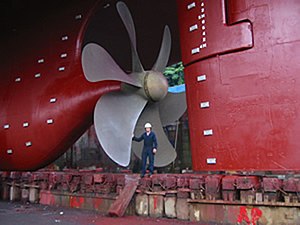
Propeller theory
In the nineteenth century, several theories concerning propellers were proposed. The momentum theory or disk actuator theory – a theory describing a mathematical model of an ideal propeller – was developed by W.J.M. Rankine (1865), A.G. Greenhill (1888) and R.E. Froude (1889). The propeller is modelled as an infinitely thin disc, inducing a constant velocity along the axis of rotation. and creating a flow around the propeller.
A screw turning through a solid will have zero "slip"; but as a propeller screw operates in a fluid (either air or water), there will be some losses. The most efficient propellers are large-diameter slow-turning screws, such as on big ships; the least efficient props are small diameter fast-turning (such as on an outboard motor). Using Newton's laws of motion, one may usefully think of a propeller's forward thrust as being a proportionate reaction to the volume of fluid sent backward; thus a large propeller will eject a bigger and heavier cylinder of fluid than will a small prop. (One could consider the efficiency of a modern aircraft's huge turbofan engine, compared to an early jetliner's small-diameter turbojet).[4]
History
Early developments
The principle employed in using a screw propeller is used in sculling. It is part of the skill of propelling a Venetian gondola but was used in a less refined way in other parts of Europe and probably elsewhere. For example, propelling a canoe with a single paddle using a "pitch stroke" or side slipping a canoe with a "scull" involves a similar technique. In China, sculling, called "lu", was also used by the 3rd century AD.
In sculling, a single blade is moved through an arc, from side to side taking care to keep presenting the blade to the water at the effective angle. The innovation introduced with the screw propeller was the extension of that arc through more than 360° by attaching the blade to a rotating shaft. Propellers can have a single blade, but in practice there are nearly always more than one so as to balance the forces involved.
The origin of the screw propeller starts with Archimedes, who used a screw to lift water for irrigation and bailing boats, so famously that it became known as Archimedes' screw. It was probably an application of spiral movement in space (spirals were a special study of Archimedes) to a hollow segmented water-wheel used for irrigation by Egyptians for centuries. Leonardo da Vinci adopted the principle to drive his theoretical helicopter, sketches of which involved a large canvas screw overhead.
In 1661, Toogood and Hays proposed using screws for waterjet propulsion, though not as a propeller.[5] Robert Hooke in 1681 designed a horizontal watermill which was remarkably similar to the Kirsten-Boeing vertical axis propeller designed almost two and a half centuries later in 1928; two years later Hooke modified the design to provide motive power for ships through water.[6] In 1693 a Frenchman by the name of Du Quet invented a screw propeller which was tried in 1693 but later abandoned.[7][8] In 1752, the Academie des Sciences in Paris granted Burnelli a prize for a design of a propeller-wheel. At about the same time, the French mathematician Alexis-Jean-Pierre Paucton, suggested a water propulsion system based on the Archimedean screw.[6] In 1771, steam-engine inventor James Watt in a private letter suggested using "spiral oars" to propel boats, although he did not use them with his steam engines, or ever implement the idea.[9]
One of the first practical and applied uses of a propeller was on a submarine dubbed Turtle which was designed in New Haven, Connecticut, in 1775 by Yale student and inventor David Bushnell, with the help of the clock maker, engraver, and brass foundryman Isaac Doolittle, and with Bushnell's brother Ezra Bushnell and ship's carpenter and clock maker Phineas Pratt constructing the hull in Saybrook, Connecticut.[10][11] On the night of September 6, 1776, Sergeant Ezra Lee piloted Turtle in an attack on HMS Eagle in New York Harbor.[12][13] Turtle also has the distinction of being the first submarine used in battle. Bushnell later described the propeller in an October 1787 letter to Thomas Jefferson: "An oar formed upon the principle of the screw was fixed in the forepart of the vessel its axis entered the vessel and being turned one way rowed the vessel forward but being turned the other way rowed it backward. It was made to be turned by the hand or foot."[14] The brass propeller, like all the brass and moving parts on Turtle, was crafted by the "ingenious mechanic" Issac Doolittle of New Haven.[15]
In 1785, Joseph Bramah in England proposed a propeller solution of a rod going through the underwater aft of a boat attached to a bladed propeller, though he never built it.[16] In 1802, Edward Shorter proposed using a similar propeller attached to a rod angled down temporarily deployed from the deck above the waterline and thus requiring no water seal, and intended only to assist becalmed sailing vessels. He tested it on the transport ship Doncaster in Gibraltar and at Malta, achieving a speed of 1.5 mph (2.4 km/h).[17]
In 1802, the American lawyer and inventor John Stevens built a 25-foot (7.6 m) boat with a rotary stem engine coupled to a four-bladed propeller. The craft achieved a speed of 4 mph (6.4 km/h), but Stevens abandoned propellers due to the inherent danger in using the high-pressure steam engines. His subsequent vessels were paddle-wheeled boats.[17]
By 1827, Czech-Austrian inventor Josef Ressel had invented a screw propeller which had multiple blades fastened around a conical base. He had tested his propeller in February 1826 on a small ship that was manually driven. He was successful in using his bronze screw propeller on an adapted steamboat (1829). His ship, Civetta of 48 gross register tons, reached a speed of about 6 knots (11 km/h). This was the first ship successfully driven by an Archimedes screw-type propeller. After a new steam engine had an accident (cracked pipe weld) his experiments were banned by the Austro-Hungarian police as dangerous. Josef Ressel was at the time a forestry inspector for the Austrian Empire. But before this he received an Austro-Hungarian patent (license) for his propeller (1827). He died in 1857. This new method of propulsion was an improvement over the paddlewheel as it was not so affected by either ship motions or changes in draft as the vessel burned coal.[18]
John Patch, a mariner in Yarmouth, Nova Scotia developed a two-bladed, fan-shaped propeller in 1832 and publicly demonstrated it in 1833, propelling a row boat across Yarmouth Harbour and a small coastal schooner at Saint John, New Brunswick, but his patent application in the United States was rejected until 1849 because he was not an American citizen.[19] His efficient design drew praise in American scientific circles[20] but by this time there were multiple competing versions of the marine propeller.
Screw propellers
Although there was much experimentation with screw propulsion until the 1830s, few of these inventions were pursued to the testing stage, and those that were proved unsatisfactory for one reason or another.[21]
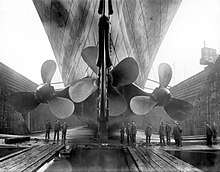
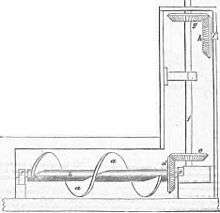
In 1835, two inventors in Britain, John Ericsson and Francis Pettit Smith, began working separately on the problem. Smith was first to take out a screw propeller patent on 31 May, while Ericsson, a gifted Swedish engineer then working in Britain, filed his patent six weeks later.[22] Smith quickly built a small model boat to test his invention, which was demonstrated first on a pond at his Hendon farm, and later at the Royal Adelaide Gallery of Practical Science in London, where it was seen by the Secretary of the Navy, Sir William Barrow. Having secured the patronage of a London banker named Wright, Smith then built a 30-foot (9.1 m), 6-horsepower (4.5 kW) canal boat of six tons burthen called Francis Smith, which was fitted with a wooden propeller of his own design and demonstrated on the Paddington Canal from November 1836 to September 1837. By a fortuitous accident, the wooden propeller of two turns was damaged during a voyage in February 1837, and to Smith's surprise the broken propeller, which now consisted of only a single turn, doubled the boat's previous speed, from about four miles an hour to eight.[22] Smith would subsequently file a revised patent in keeping with this accidental discovery.
In the meantime, Ericsson built a 45-foot (14 m) screw-propelled steamboat, Francis B. Ogden in 1837, and demonstrated his boat on the River Thames to senior members of the British Admiralty, including Surveyor of the Navy Sir William Symonds. In spite of the boat achieving a speed of 10 miles an hour, comparable with that of existing paddle steamers, Symonds and his entourage were unimpressed. The Admiralty maintained the view that screw propulsion would be ineffective in ocean-going service, while Symonds himself believed that screw propelled ships could not be steered efficiently.[23] Following this rejection, Ericsson built a second, larger screw-propelled boat, Robert F. Stockton, and had her sailed in 1839 to the United States, where he was soon to gain fame as the designer of the U.S. Navy's first screw-propelled warship, USS Princeton.[24]
Apparently aware of the Royal Navy's view that screw propellers would prove unsuitable for seagoing service, Smith determined to prove this assumption wrong. In September 1837, he took his small vessel (now fitted with an iron propeller of a single turn) to sea, steaming from Blackwall, London to Hythe, Kent, with stops at Ramsgate, Dover and Folkestone. On the way back to London on the 25th, Smith's craft was observed making headway in stormy seas by officers of the Royal Navy. The Admiralty's interest in the technology was revived, and Smith was encouraged to build a full size ship to more conclusively demonstrate the technology's effectiveness.[25]
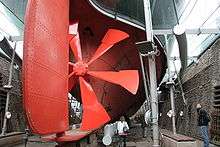
SS Archimedes was built in 1838 by Henry Wimshurst of London, as the world's first steamship[26] to be driven by a screw propeller.[27][28][29][30]
Archimedes had considerable influence on ship development, encouraging the adoption of screw propulsion by the Royal Navy, in addition to her influence on commercial vessels. Trials with Smith's Archimedes led to the famous tug-of-war competition in 1845 between the screw-driven HMS Rattler and the paddle steamer HMS Alecto; the former pulling the latter backward at 2.5 knots (4.6 km/h).
She also had a direct influence on the design of another innovative vessel, Isambard Kingdom Brunel's SS Great Britain in 1843, then the world's largest ship and the first screw-propelled steamship to cross the Atlantic Ocean in August 1845.
HMS Terror and HMS Erebus were both heavily modified to become the first Royal Navy ships to have steam-powered engines and screw propellers. Both participated in Franklin's lost expedition, last seen by Europeans in July 1845 near Baffin Bay.
Screw propeller design stabilized in the 1880s.
Shaftless propellers
Propellers without a central shaft consist of propeller blades attached to a ring which is part of a circle-shaped electric motor. This design is known as a Rim-driven thruster and has been used by some small, self-guided robotic ships. A boat with this type of propeller is known as an unscrewed surface vessel.
Aircraft propellers

The twisted aerofoil shape of modern aircraft propellers was pioneered by the Wright brothers. While some earlier engineers had attempted to model air propellers on marine propellers, the Wrights realized that a propeller is essentially the same as a wing, and were able to use data from their earlier wind tunnel experiments on wings. They also introduced a twist along the length of the blades. This was necessary to ensure the angle of attack of the blades was kept relatively constant along their length.[31] Their original propeller blades were only about 5% less efficient than the modern equivalent, some 100 years later.[32] The understanding of low speed propeller aerodynamics was fairly complete by the 1920s, but later requirements to handle more power in smaller diameter have made the problem more complex.
Alberto Santos Dumont, another early pioneer, applied the knowledge he gained from experiences with airships to make a propeller with a steel shaft and aluminium blades for his 14 bis biplane. Some of his designs used a bent aluminium sheet for blades, thus creating an airfoil shape. They were heavily undercambered, and this plus the absence of lengthwise twist made them less efficient than the Wright propellers. Even so, this was perhaps the first use of aluminium in the construction of an airscrew.
Cavitation
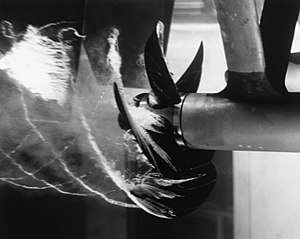
Cavitation is the formation of vapor bubbles in water near a moving propeller blade in regions of low pressure due to Bernoulli's principle. It can occur if an attempt is made to transmit too much power through the screw, or if the propeller is operating at a very high speed. Cavitation can waste power, create vibration and wear, and cause damage to the propeller. It can occur in many ways on a propeller. The two most common types of propeller cavitation are suction side surface cavitation and tip vortex cavitation.
Suction side surface cavitation forms when the propeller is operating at high rotational speeds or under heavy load (high blade lift coefficient). The pressure on the upstream surface of the blade (the "suction side") can drop below the vapor pressure of the water, resulting in the formation of a vapor pocket. Under such conditions, the change in pressure between the downstream surface of the blade (the "pressure side") and the suction side is limited, and eventually reduced as the extent of cavitation is increased. When most of the blade surface is covered by cavitation, the pressure difference between the pressure side and suction side of the blade drops considerably, as does the thrust produced by the propeller. This condition is called "thrust breakdown". Operating the propeller under these conditions wastes energy, generates considerable noise, and as the vapor bubbles collapse it rapidly erodes the screw's surface due to localized shock waves against the blade surface.
Tip vortex cavitation is caused by the extremely low pressures formed at the core of the tip vortex. The tip vortex is caused by fluid wrapping around the tip of the propeller; from the pressure side to the suction side. This video demonstrates tip vortex cavitation. Tip vortex cavitation typically occurs before suction side surface cavitation and is less damaging to the blade, since this type of cavitation doesn't collapse on the blade, but some distance downstream.
Types of marine propellers
Controllable-pitch propeller
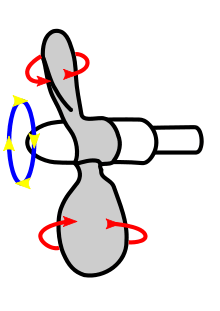
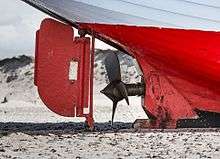
The controllable-pitch propeller (also variable-pitch propeller) has significant advantages over the fixed-pitch variety, which include:
- selecting the most effective blade angle for any given speed.
- when motorsailing, the ability to coarsen the blade angle to attain the optimum drive from wind and engines.
- the ability to move astern (in reverse) much more efficiently. (Fixed props perform very poorly in astern).
- the ability to "feather" the blades to give the least resistance when not in use (e.g. when sailing).
Skewback propeller
An advanced type of propeller used on German Type 212 submarines is called a skewback propeller. As in the scimitar blades used on some aircraft, the blade tips of a skewback propeller are swept back against the direction of rotation. In addition, the blades are tilted rearward along the longitudinal axis, giving the propeller an overall cup-shaped appearance. This design preserves thrust efficiency while reducing cavitation, and thus makes for a quiet, stealthy design.[33][34]
A small number of ships use propellers with winglets similar to those on some airplanes, reducing tip vortices and improving efficiency.[35][36][37][38][39]
Modular propeller
A modular propeller provides more control over the boat's performance. There is no need to change an entire prop, when there is an opportunity to only change the pitch or the damaged blades. Being able to adjust pitch will allow for boaters to have better performance while in different altitudes, water sports, and/or cruising.[40]
Voith Schneider propeller
Voith Schneider propellers use four untwisted straight blades turning around a vertical axis instead of helical blades and can provide thrust in any direction at any time, at the cost of higher mechanical complexity.
Devices to protect engines from damage after prop strikes or rope fouling
Shaft protection
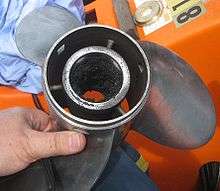
For smaller engines, such as outboards, where the propeller is exposed to the risk of collision with heavy objects, the propeller often includes a device that is designed to fail when overloaded; the device or the whole propeller is sacrificed so that the more expensive transmission and engine are not damaged.
Typically in smaller (less than 10 hp or 7.5 kW) and older engines, a narrow shear pin through the drive shaft and propeller hub transmits the power of the engine at normal loads. The pin is designed to shear when the propeller is put under a load that could damage the engine. After the pin is sheared the engine is unable to provide propulsive power to the boat until a new shear pin is fitted.[41]
In larger and more modern engines, a rubber bushing transmits the torque of the drive shaft to the propeller's hub. Under a damaging load the friction of the bushing in the hub is overcome and the rotating propeller slips on the shaft, preventing overloading of the engine's components.[42] After such an event the rubber bushing may be damaged. If so, it may continue to transmit reduced power at low revolutions, but may provide no power, due to reduced friction, at high revolutions. Also, the rubber bushing may perish over time leading to its failure under loads below its designed failure load.
Whether a rubber bushing can be replaced or repaired depends upon the propeller; some cannot. Some can, but need special equipment to insert the oversized bushing for an interference fit. Others can be replaced easily. The "special equipment" usually consists of a funnel, a press and rubber lubricant (soap). If one does not have access to a lathe, an improvised funnel can be made from steel tube and car body filler; as the filler is only subject to compressive forces it is able to do a good job. Often, the bushing can be drawn into place with nothing more complex than a couple of nuts, washers and a threaded rod. A more serious problem with this type of propeller is a "frozen-on" spline bushing, which makes propeller removal impossible. In such cases the propeller must be heated in order to deliberately destroy the rubber insert. Once the propeller is removed, the splined tube can be cut away with a grinder and a new spline bushing is then required. To prevent a recurrence of the problem, the splines can be coated with anti-seize anti-corrosion compound.
In some modern propellers, a hard polymer insert called a drive sleeve replaces the rubber bushing. The splined or other non-circular cross section of the sleeve inserted between the shaft and propeller hub transmits the engine torque to the propeller, rather than friction. The polymer is weaker than the components of the propeller and engine so it fails before they do when the propeller is overloaded.[43] This fails completely under excessive load, but can easily be replaced.
Weed hatches and rope cutters
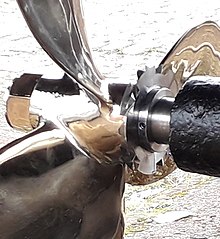
Whereas the propeller on a large ship will be immersed in deep water and free of obstacles and flotsam, yachts, barges and river boats often suffer propeller fouling by debris such as weed, ropes, cables, nets and plastics. British narrowboats invariably have a weed hatch over the propeller, and once the narrowboat is stationary, the hatch may be opened to give access to the propeller, enabling debris to be cleared. Yachts and river boats rarely have weed hatches; instead they may fit a rope cutter that fits around the prop shaft and rotates with the propeller. These cutters clear the debris and obviate the need for divers to attend manually to the fouling. Rope cutters take four forms:[44][45]
- (1) A simple sharp edged disc that cuts like a razor;[46]
- (2) A rotor with two or more projecting blades that slice against a fixed blade, cutting with a scissor action;[47][48][49]
- (3) A serrated rotor with a complex cutting edge made up of sharp edges and projections.[50]
- (4) A development of the type 2 cutter, he "QuickKutter" is a simpler, more rugged, alternative. Having no rotor, it instead uses the propeller blades to wind the rope (or debris) forward onto a composite spool forward of the propeller hub and it, whereupon the rope is cut by a robust fixed blade. [51]
Propeller variations
Cleaver
A cleaver is a type of propeller design especially used for boat racing. Its leading edge is formed round, while the trailing edge is cut straight. It provides little bow lift, so that it can be used on boats that do not need much bow lift, for instance hydroplanes, that naturally have enough hydrodynamic bow lift. To compensate for the lack of bow lift, a hydrofoil may be installed on the lower unit. Hydrofoils reduce bow lift and help to get a boat out of the hole and onto plane.
See also
- Screw-propelled vehicle – Vehicle propelled by load-bearing rotating helical flanges
Propeller characteristics
- Advance ratio – Ratio of freestream speed to tip speed
- Axial fan design
Propeller phenomena
- Propeller walk – Tendency of a propeller to yaw a vessel during acceleration
- Cavitation – Formation of vapour-filled low-pressure voids in a liquid
Other
- Adjustable pitch propeller
- Azimuth thruster – Steerable propulsion pod under a watercraft
- Azipod – Electric drive azimuth thruster
- Bow/stern thruster – Transverse or steerable propulsion device in a watercraft
- Controllable pitch propeller
- Ducted propeller – Marine propeller with a non-rotating nozzle
- Pump-jet – Marine propulsion system
- Folding propeller – Propeller with blades that fold open when rotating
- Helix – Type of smooth space curve
- Impeller – Rotor used to increase (or decrease in case of turbines) the pressure and flow of a fluid or gas
- Kitchen rudder – Type of directional propulsion system for vessels
- Modular propeller
- Paddle steamer – Steam-powered vessel propelled by paddle wheels
- Pleuger rudder – A thruster assisted ship's rudder
- Propulsor – A machinical device to propel a vessel
- Supercavitating propeller – Marine propeller designed to operate with a full cavitation bubble
- Variable-pitch propeller – Propeller with blades that can be rotated to control their pitch while in use
- Voith-Schneider propeller – Perpendicular axis marine propulsion system
- Wake-equalising duct – Ship hull appendage to modify propeller inflow
Materials and manufacture
| External video | |
|---|---|
- Balancing machine
- Composite materials
Notes
- "Propeller". Encyclopedia Britannica. Retrieved 2019-12-04.
- "NASA website article - Propeller Propulsion". May 5, 2015.
- Note: on many boats, the prop shaft is not horizontal but dips towards the stern. Although this is often forced upon the designer by hull shape, it gives a small benefit by helping to counter any Squat effect.
- How propellers work - https://www.deepblueyachtsupply.com/boat-propeller-theory
- Carlton, John, Marine Propellers and Propulsion Butterworth-Heinemann, 2012, p. 363
- Carlton, p. 1
- Bourne, John (April 10, 1855). "A Treatise on the Screw Propeller: With Various Suggestions of Improvement". Longman, Brown, Green, and Longmans – via Google Books.
- "Patents for Inventions: Abridgments of Specifications : Class ..." Patent Office. April 10, 1857 – via Google Books.
- Murihead, James Patrick, The Life of James Watt, with Selections from His Correspondence ... With Portraits and Woodcuts, London: John Murray, 1858, p. 208
- Stein, Stephen K. The Sea in World History: Exploration, Travel, and Trade [2 volumes], Editor Stephen K. Stein, ABC-CLIO, 2017, Volume 1, p. 600
- Manstan, Roy R.; Frese, Frederic J., Turtle: David Bushnell's Revolutionary Vessel, Yardley, Pa: Westholme Publishing. ISBN 978-1-59416-105-6. OCLC 369779489, 2010, pp. xiii, 52, 53
- Tucker, Spencer, Almanac of American Military History, ABC-CLIO, 2013, Volume 1, p. 305
- Mansten pp. xiii, xiv
- Nicholson, William, A Journal of Natural Philosophy, Chemistry and the Arts, Volume 4, G. G. and J. Robinson, 1801, p. 221
- Manstan, p.150
- Carlton, pp. 1–2
- Carlton, p.2
- Paul Augustin Normand, La Genèse de l'Hélice Propulsive (The Genesis of the Screw Propulsor). Paris: Académie de Marine, 1962, pp. 31–50.
- Mario Theriault, Great Maritime Inventions Goose Lane Publishing (2001) pp. 58–59
- ""Patch's Propeller", Scientific America, Vol. 4, No. 5 (October 10, 1848) p. 33, featured in The Archimedes Screw website retrieved 31 January 2010". Archived from the original on July 8, 2011.
- Smith, Edgar C. (1905). A Short history of Naval and Marine Engineering. University Press, Cambridge. pp. 66–67.
- Bourne, p. 84.
- In the case of Francis B. Ogden, Symonds was correct. Ericsson had made the mistake of placing the rudder forward of the propellers, which made the rudder ineffective. Symonds believed that Ericsson tried to disguise the problem by towing a barge during the test.
- Bourne, pp. 87–89.
- Bourne, p. 85.
- The emphasis here is on ship. There were a number of successful propeller-driven vessels prior to Archimedes, including Smith's own Francis Smith and Ericsson's Francis B. Ogden and Robert F. Stockton. However, these vessels were boats – designed for service on inland waterways – as opposed to ships, built for seagoing service.
- "The type of screw propeller that now propels the vast majority of boats and ships was patented in 1836, first by the British engineer Francis Pettit Smith, then by the Swedish engineer John Ericsson. Smith used the design in the first successful screw-driven steamship, Archimedes, which was launched in 1839.". Marshall Cavendish, p. 1335.
- "The propeller was invented in 1836 by Francis Pettit Smith in Britain and John Ericsson in the United States. It first powered a seagoing ship, appropriately called Archimedes, in 1839." Macauley and Ardley, p. 378.
- "In 1839, the Messrs. Rennie constructed the engines, machinery and propeller, for the celebrated Archimedes, from which may be said to date the introduction of the screw system of propulsion ...". Mechanics Magazine, p. 220.
- "It was not until 1839 that the principle of propelling steamships by a screw blade was fairly brought before the world, and for this we are indebted, as almost every adult will remember, to Mr. F. P. Smith of London. He was the man who first made the screw propeller practically useful. Aided by spirited capitalists, he built a large steamer named the "Archimedes", and the results obtained from her at once arrested public attention.". MacFarlane, p. 109.
- Pilot's Handbook of Aeronautical Knowledge. Oklahoma City: U.S. Federal Aviation Administration. 2008. pp. 2–7. FAA-8083-25A.
- Ash, Robert L., Colin P. Britcher and Kenneth W. Hyde. "Wrights: How two brothers from Dayton added a new twist to airplane propulsion." Mechanical Engineering: 100 years of Flight, 3 July 2007.
- "SILENT propellers". www.francehelices.fr. JMCWebCreation and Co. 2009. Archived from the original on September 26, 2007. Retrieved July 21, 2017.
- About Propellers http://www.gsitek-props.co.uk/about_propellers.htm
- Godske, Bjørn. "Energy saving propeller" (in Danish) Ingeniøren, 23 April 2012. Accessed: 15 March 2014. English translation
- Godske, Bjørn. "Kappel-propellers pave the way for success at MAN" (in Danish) Ingeniøren, 15 March 2014. Accessed: 15 March 2014. English translation
- "Kappel agreement secures access to major market" 30 August 2013.
- "KAPRICCIO Project Archived 2014-03-15 at the Wayback Machine" European Union. Accessed: 15 March 2014.
- "Industry Pays Tribute to Innovation Awards Winners" Marine link, 3 October 2002. Accessed: 15 March 2014. Quote: "Winner: the energy-saving Kappel propeller concept from the European Commission-funded Kapriccio propulsion research project. Blades curved towards the tips on the suction side reduce energy losses, fuel consumption, noise and vibration"
- Smrcka, Karel (March 18, 2005). "A new start for marine propellers". Engineering News. Retrieved July 21, 2017.
- Getchell, David (1994), The Outboard Boater's Handbook, ISBN 9780070230538
- Ministry Of Defence (Navy), Great Britain (1995), Admiralty Manual of Seamanship, ISBN 9780117726963
- US, "Torsionally twisting propeller drive sleeve and adapter", published March 8, 1994, issued January 16, 1996
- Comparison of Rope Cutter Types - http://www.h4marine.com/Types.htm
- Yachting World rope cutter test https://www.yachtingmonthly.com/gear/propeller-rope-cutter-test-30012
- Simple disc cutters https://www.asap-supplies.com/propeller-drivetrain/rope-cutters
- Spurs scissor-action rope cutter https://www.spursmarine.com/shaft-cutters/
- Stripper scissor-action rope cutter past://ropestripper.com/strippers.php
- Gator cissor-action rope cutter http://www.propprotect.com
- Images of rope cutters. https://www.bing.com/images/search?q=yacht+rope+cutter&id=9A2642834983B967EF5261F4A95842DA499E0528&form=IQFRBA&first=1&scenario=ImageBasicHover
- QuickKutter http://www.h4marine.com/QuicKutter01.htm
External links
| Wikimedia Commons has media related to Propellers. |
- Titanic's Propellers
- Theory calculation propellers and wings: detailed article with blade element theory software application
- "What You Should Know About Propellers For Our Fighting Planes", November 1943, Popular Science extremely detailed article with numerous drawings and cutaway illustrations
- Archimedes Screw History: The story of marine propulsion
- propellers history: The story of propellers
- Propulsors and gears: Wartsila Marine Propellers
- Propeller Drop:-Measured by feeler gauge